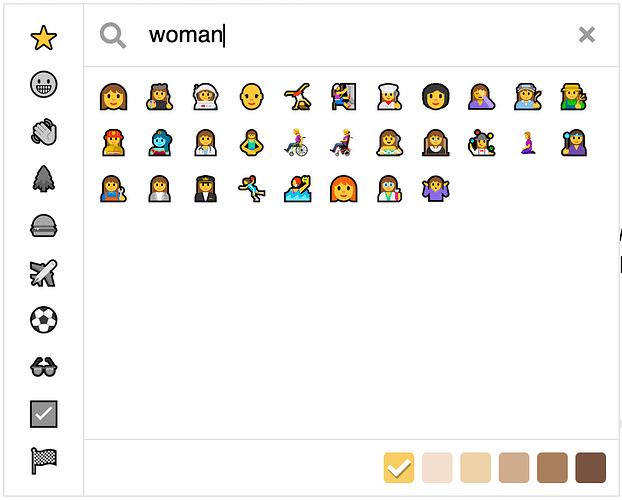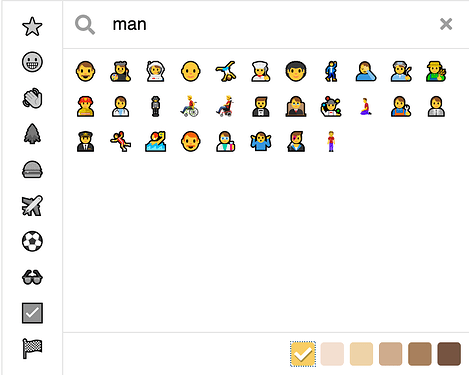The forum software for this site is called Discourse, and in general it’s pretty great. You may have noticed that it has a little pop-up box for choosing emoji. It’s kind of fun. There are a lot of emoji already (and more in the pipeline). They have pretty quickly become an important part of the visual lexicon of the web and in particular social media.
If you search for “woman” you get this:
If you search for “man” you get this:
The faces are all a kind of Simpsons-esque yellow, and that’s the default. In the early stages of the design of Emoji, the Unicode Consortium (the people who put the Unicode standard together) were doing all representations of humans with this yellow color. Such decisions get published in rather obscure places, at least, they are obscure compared to the scale of the impact that they can have on visual culture at large. For instance, the following snippet was pointed out by this article (whose author’s name I cannot find on the page!) as coming from a draft of Unicode Technical Report #51.
General-purpose emoji for people and body parts should also not be given overly specific images: the general recommendation is to be as neutral as possible regarding race, ethnicity, and gender. Thus for the character U+1F64B happy person raising one hand , the recommendation is to use a neutral graphic like
instead of an overly-specific image like
. This includes the characters listed in the annotations chart under “human”. The representative glyph used in the charts, or images from other vendors may be misleading: for example, the construction worker
may be male or female.
So, obviously, the problem here is that there’s no such thing as “neutral” when it comes to representing people. That fact makes it very difficult to design user interfaces which are respectful of all users. For instance, here in this discourse forum software, how should the user interface for representing humans in emoji work?
Enter skin tone emoji
So, the Unicode Consortium has tried to come around on this issue, and to improve the flexibility of the representation of people. What they did was to add “skin-tone emoji” as independent characters. When a skin-tone emoji follows an emoji that represents a human, then that representation’s skin tone is modulated accordingly. There are five skin tones available (derived from a scale used in dermatology!). In our forum software, that results in the following possibilities for the “man” and “woman” characters (I shuffled them):
![]()
![]()
![]()
![]()
![]()
![]()
![]()
![]()
![]()
![]()
![]()
![]()
![]()
![]()
![]()
![]()
![]()
![]()
![]()
![]()
![]()
![]()
![]()
![]()
![]()
![]()
![]()
![]()
![]()
![]()
![]()
![]()
![]()
![]()
![]()
![]()
![]()
![]()
![]()
![]()
![]()
![]()
![]()
![]()
![]()
![]()
![]()
![]()
![]()
![]()
![]()
![]()
![]()
![]()
![]()
![]()
![]()
![]()
![]()
![]()
![]()
![]()
![]()
![]()
![]()
![]()
![]()
![]()
![]()
![]()
![]()
![]()
![]()
![]()
![]()
![]()
![]()
![]()
![]()
![]()
![]()
![]()
![]()
![]()
![]()
![]()
![]()
![]()
![]()
![]()
![]()
![]()
![]()
![]()
![]()
![]()
![]()
![]()
![]()
![]()
But as current events are serving to remind us, we should always be questioning defaults. Software has a tricky characteristic: once something is working, it can be hard to change, because other things depend on it. Software gets tangled.
In point of fact, there are far more possibilities for representing human diversity built into Unicode than are represented in the list above. The list is bigger.
There has been some interesting research on how people are actually using these emoji on public venues like Twitter. Lots to think about on this topic. I guess I’m just pointing it out because it is a good reminder that every decision about software design and implementation must grapple with the notions of “defaults”, even when dealing with topics for which there are no defaults, at least, no neutral defaults.
Resources
Self-Representation on Twitter Using Emoji Skin Color Modifiers

